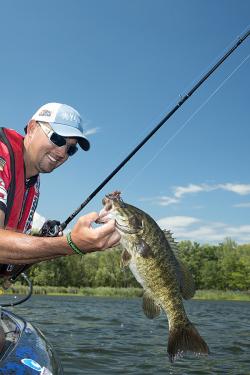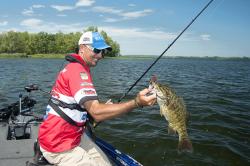Changes in Weather Often Mean Changes in Lures
Autumn’s Cooler Temperatures Can Affect How Certain Fish Feed
Although cold fronts and other weather changes in the autumn months are seldom as severe as those occurring later in the winter, they can still change bass behavior very quickly. That’s why Yamaha Pro Marty Robinson always has several rods with completely different types of lures rigged and ready to cast whenever he goes fishing this time of year.
Yamaha pro angler Marty Robinson switches to a jig when sustained north winds start to blow, slowing action on buzzbaits and spinnerbaits.“The cold fronts in the autumn normally don’t change the water temperature that much,” notes Robinson, “but they often change the wind speed and direction, and that seems to be what changes the fish.
“I know from experience that whenever a front changes the wind direction from the south to the north, for example, the fishing is going to slow dramatically.”
One of Robinson’s favorite fall lures, and a favorite of bass fishermen everywhere, is a topwater buzz bait, a noisy lure with a rotating blade that churns and clatters through shallow cover and often attracts big bass. It seems to produce best when the wind is blowing from the south, but a change to a north wind all but eliminates the bite.
Robinson’s solution is to change to a lure he can fish close to the surface but not on top of the water. His favorite choice is a spinnerbait, which he retrieves fast, or “burns,” just below the surface. If the spinnerbait doesn’t produce, he then changes to jigs or soft plastic creature baits and worms.
“I’ve really caught a lot of fish burning the spinnerbait over submerged cover like stumps, laydowns, rocks, and vegetation,” continues the Yamaha Pro. “The bass still seem to be very active and they strike reactively, but they apparently don’t want to actually break the surface. Sometimes, just a simple presentation change like this is all that’s needed to start the fish biting again.
“Other times, slowing down and fishing specific targets more thoroughly may be what’s needed. This is when I start pitching and flipping a jig or some other bottom-bumping lure, and instead of just making one or two casts to a log or stump, I’ll make five or six and fish much slower and tighter to the cover.”
When fishing really slows, Robinson frequently changes his fishing targets as well as his lures. Instead of concentrating on stumps or laydowns, he looks for thick vegetation, such as milfoil, hydrilla, or other greenery in shallow water.
Robinson says he sometimes finds more fish under weed mats than in open water cover as the water cools, but the jig is a good weapon in the mats, as well.“During the autumn months, vegetation will be the thickest it’s going to be all year,” he explains, “and it will attract both baitfish and bass and hold them well into the winter. In some lakes where the vegetation forms a mat at the surface, you can bring fish up with plastic frogs, but flipping jigs and soft plastics may produce even better results.
“I’ll work along the edge of the matted vegetation, and flip into little holes and to any irregular points, let the jig reach the bottom, and just hop it once or twice. If a bass is there, it will usually strike pretty quickly.”
The Yamaha Pro also pays attention to the late afternoon rain showers that often come with autumn weather changes. Immediately before the rain starts falling, the fishing can be excellent, but once the bass stop biting, it may take as long as 24 hours for them to really become active again.
“Part of this is caused by a changing barometer,” concludes the Yamaha Pro, “but you can fish your way through it. When the barometer is falling, as it usually is as a storm approaches, the bass are nearly always more active and will really hit spinnerbaits and crankbaits, but they stop biting once the barometer starts rising immediately after the front passes. When you know this is happening, you just have to slow down and fish more carefully with more target-specific lures until the barometer settles again.
“That’s why I think it’s important to have a variety of lures rigged and ready to use during the fall months. The bass can change their behavior very quickly, but you can still catch them.”

